#Ancient technology
Explore tagged Tumblr posts
Text

Ancient Technology
#artists on tumblr#original photographers#original photography#hiking#pacific northwest#nature#washington#pnw#nikon#orofeaiel#abandoned#vintage#forest finds#ancient technology#woods#found objects#found items#nature reclaiming#moss#back to nature
766 notes
·
View notes
Text










The sublime and beautiful sci-fi-themed creations of Derek Jones - https://www.this-is-cool.co.uk/the-sublime-and-beautiful-sci-fi-creations-of-derek-jones/
#Derek Jones#this-is-cool#scififantasyhorror#digital art#sci-fi art#concept art#science fiction art#concept artist#sci-fi artist#digital artist#concept designer#futuristic art#ancient technology
2K notes
·
View notes
Text



Earliest evidence of dental implants, adorned by Pharoahs
278 notes
·
View notes
Text
April 14, Xi'an, China, Shaanxi History Museum, Qin and Han Dynasties Branch (Part 3 – Innovations and Philosophies):
(Edit: sorry this post came out so late, I got hit by the truck named life and had to get some rest, and this post in itself took some effort to research. But anyway it's finally up, please enjoy!)
A little background first, because this naming might lead to some confusions.....when you see location adjectives like "eastern", "western", "northern", "southern" added to the front of Zhou dynasty, Han dynasty, Song dynasty, and Jin/晋 dynasty, it just means the location of the capital city has changed. For example Han dynasty had its capital at Chang'an (Xi'an today) in the beginning, but after the very brief but not officially recognized "Xin dynasty" (9 - 23 AD; not officially recognized in traditional Chinese historiography, it's usually seen as a part of Han dynasty), Luoyang became the new capital. Because Chang'an is geographically to the west of Luoyang, the Han dynasty pre-Xin is called Western Han dynasty (202 BC - 8 AD), and the Han dynasty post-Xin is called Eastern Han dynasty (25 - 220 AD). As you can see here, in these cases this sort of adjective is simply used to indicate different time periods in the same dynasty.
Model of a dragonbone water lift/龙骨水车, Eastern Han dynasty. This is mainly used to push water up to higher elevations for the purpose of irrigation:
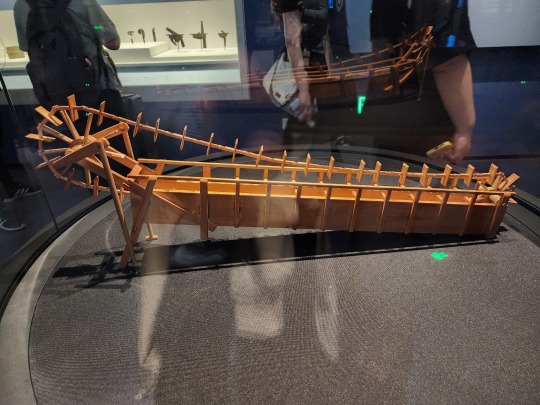
Model of a water-powered bellows/冶铁水排, Eastern Han dynasty. Just as the name implies, as flowing water pushes the water wheel around, the parts connected to the axle will pull and push on the bellows alternately, delivering more air to the furnace for the purpose of casting iron.
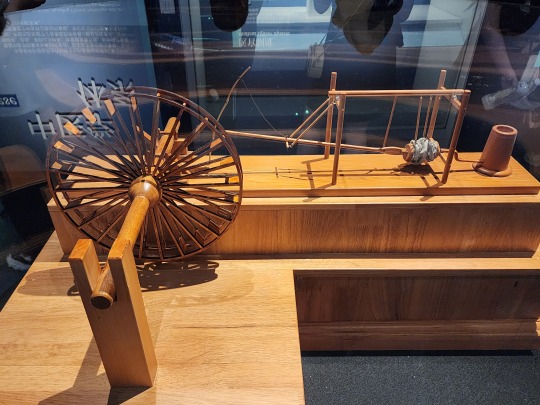
The Nine Chapters on the Mathematical Art/《九章算术》, Fangcheng/方程 chapter. It’s a compilation of the work of many scholars from 10 th century BC until 2 nd century AD, and while the earliest authors are unknown, it has been edited and supplemented by known scholars during Western Han dynasty (also when the final version of this book was compiled), then commented on by scholars during Three Kingdoms period (Kingdom of Wei) and Tang dynasty. The final version contains 246 example problems and solutions that focus on practical applications, for example measuring land, surveying land, construction, trading, and distributing taxes. This focus on practicality is because it has been used as a textbook to train civil servants. Note that during Han dynasty, fangcheng means the method of solving systems of linear equations; today, fangcheng simply means equation. For anyone who wants to know a little more about this book and math in ancient China, here’s an article about it. (link goes to pdf)
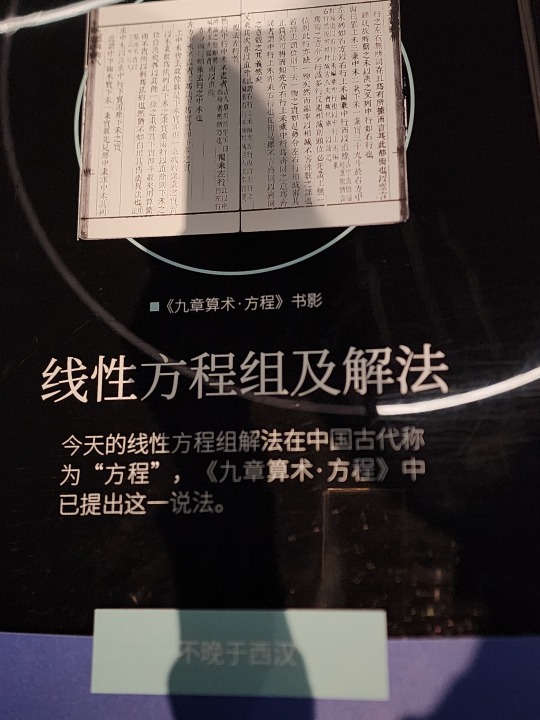
Diagram of a circle in a right triangle (called “勾股容圆” in Chinese), from the book Ceyuan Haijing/《测圆海镜》 by Yuan-era mathematician Li Ye/李冶 (his name was originally Li Zhi/李治) in 1248. Note that Pythagorean Theorem was known by the name Gougu Theorem/勾股定理 in ancient China, where gou/勾 and gu/股 mean the shorter and longer legs of the right triangle respectively, and the hypotenuse is named xian/弦 (unlike what the above linked article suggests, this naming has more to do with the ancient Chinese percussion instrument qing/磬, which is shaped similar to a right triangle). Gougu Theorem was recorded in the ancient Chinese mathematical work Zhoubi Suanjing/《周髀算经》, and the name Gougu Theorem is still used in China today.
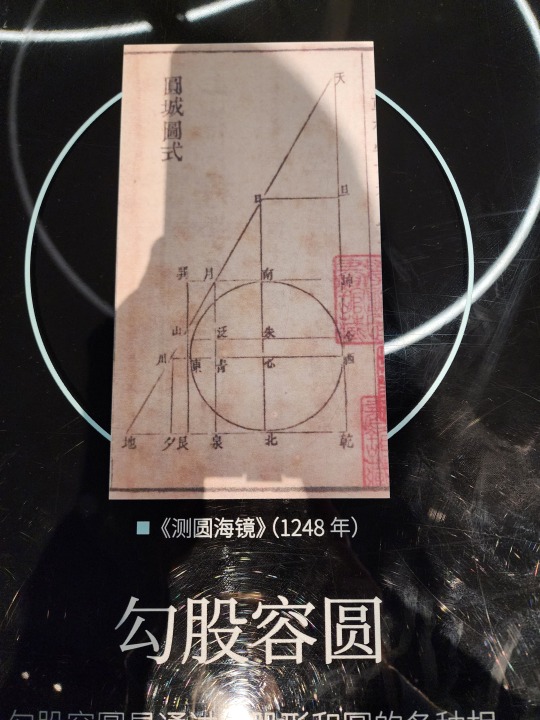
Diagram of the proof for Gougu Theorem in Zhoubi Suanjing. The sentence on the left translates to "gou (shorter leg) squared and gu (longer leg) squared makes up xian (hypotenuse) squared", which is basically the equation a² + b² = c². Note that the character for "squared" here (mi/幂) means "power" today.

This is a diagram of Zhang Heng’s seismoscope, called houfeng didong yi/候风地动仪 (lit. “instrument that measures the winds and the movements of the earth”). It was invented during Eastern Han dynasty, but no artifact of houfeng didong yi has been discovered yet, this is presumably due to constant wars at the end of Eastern Han dynasty. All models and diagrams that exist right now are what historians and seismologists think it should look like based on descriptions from Eastern Han dynasty. This diagram is based on the most popular model by Wang Zhenduo that has an inverted column at the center, but this model has been widely criticized for its ability to actually detect earthquakes. A newer model that came out in 2005 with a swinging column pendulum in the center has shown the ability to detect earthquakes, but has yet to demonstrate ability to reliably detect the direction where the waves originate, and is also inconsistent with the descriptions recorded in ancient texts. What houfeng didong yi really looks like and how it really works remains a mystery.
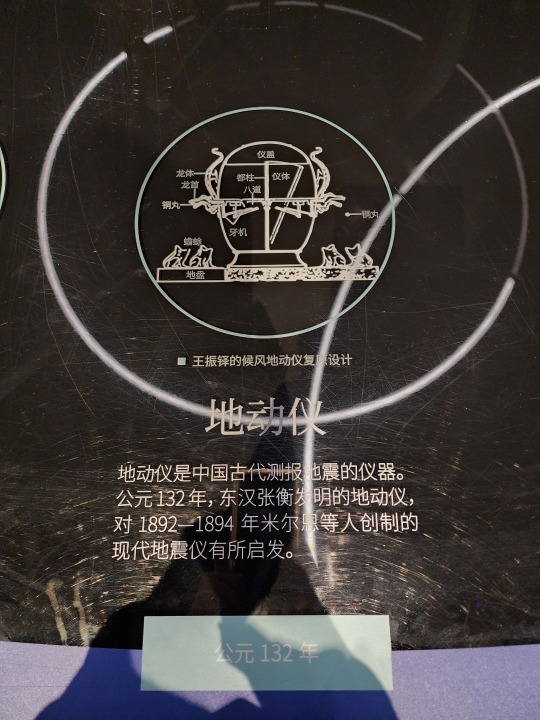
Xin dynasty bronze calipers, the earliest sliding caliper found as of now (not the earliest caliper btw). This diagram is the line drawing of the actual artifact (right).
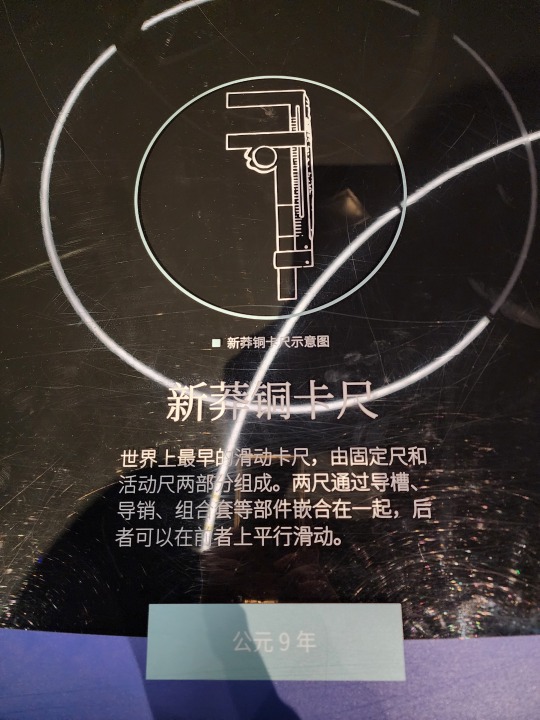

Ancient Chinese "Jacquard" loom (called 提花机 or simply 花机 in Chinese, lit. "raise pattern machine"), which first appeared no later than 1st century BC. The illustration here is from the Ming-era (1368 - 1644) encyclopedia Tiangong Kaiwu/《天工开物》. Basically it's a giant loom operated by two people, the person below is the weaver, and the person sitting atop is the one who controls which warp threads should be lifted at what time (all already determined at the designing stage before any weaving begins), which creates patterns woven into the fabric. Here is a video that briefly shows how this type of loom works (start from around 1:00). For Hanfu lovers, this is how zhuanghua/妆花 fabric used to be woven, and how traditional silk fabrics like yunjin/云锦 continue to be woven. Because it is so labor intensive, real jacquard silk brocade woven this way are extremely expensive, so the vast majority of zhuanghua hanfu on the market are made from machine woven synthetic materials.
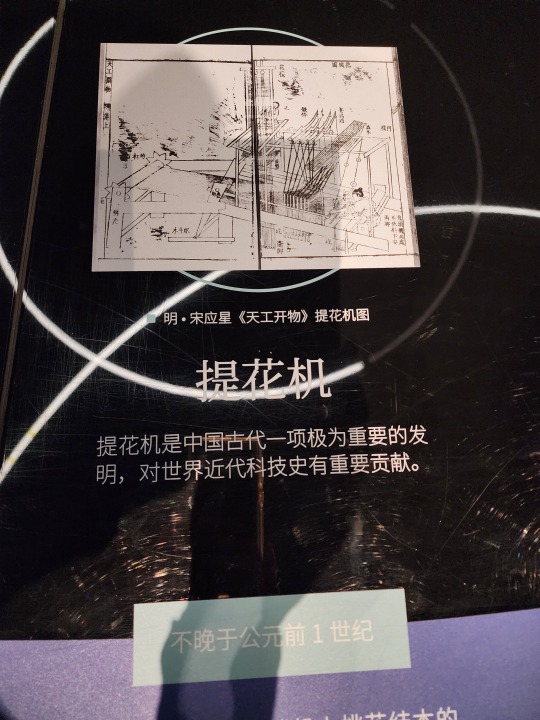
Chinese purple is a synthetic pigment with the chemical formula BaCuSi2O6. There's also a Chinese blue pigment. If anyone is interested in the chemistry of these two compounds, here's a paper on the topic. (link goes to pdf)

A list of common colors used in Qin and Han dynasties and the pigments involved. White pigment comes from chalk, lead compounds, and powdered sea shells; green pigment comes from malachite mineral; blue pigment usually comes from azurite mineral; black comes from pine soot and graphite; red comes from cinnabar; ochre comes from hematite; and yellow comes from realgar and orpiment minerals.

Also here are names of different colors and shades during Han dynasty. It's worth noting that qing/青 can mean green (ex: 青草, "green grass"), blue (ex: 青天, "blue sky"), any shade between green and blue, or even black (ex: 青丝, "black hair") in ancient Chinese depending on the context. Today 青 can mean green, blue, and everything in between.

Western Han-era bronze lamp shaped like a goose holding a fish in its beak. This lamp is interesting as the whole thing is hollow, so the smoke from the fire in the lamp (the fish shaped part) will go up into the neck of the goose, then go down into the body of the goose where there's water to catch the smoke, this way the smoke will not be released to the surrounding environment. There are also other lamps from around the same time designed like this, for example the famous gilt bronze lamp that's shaped like a kneeling person holding a lamp.
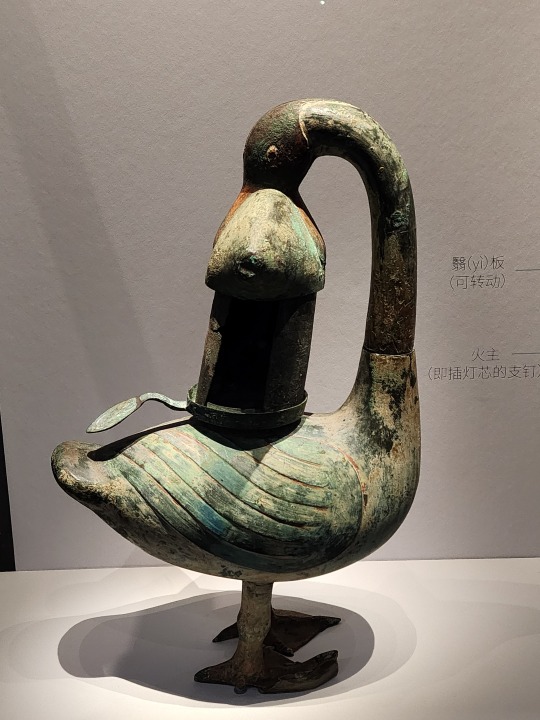
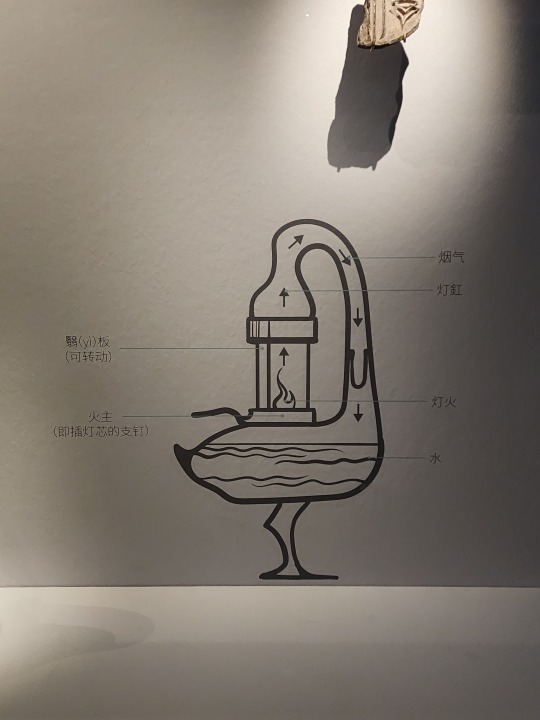
Part of a Qin-era (?) clay drainage pipe system:

A list of canals that was dug during Warring States period, Qin dynasty, and pre-Emperor Wu of Han Han dynasty (475 - 141 BC). Their purposes vary from transportation to irrigation. The name of the first canal on the list, Hong Gou/鸿沟, has already become a word in Chinese language, a metaphor for a clear separation that cannot be crossed (ex: 不可逾越的鸿沟, meaning "a gulf that cannot be crossed").

Han-era wooden boat. This boat is special in that its construction has clear inspirations from the ancient Romans, another indication of the amount of information exchange that took place along the Silk Road:

A model that shows how the Great Wall was constructed in Qin dynasty. Laborers would use bamboo to construct a scaffold (bamboo scaffolding is still used in construction today btw, though it's being gradually phased out) so people and materials (stone bricks and dirt) can get up onto the wall. Then the dirt in the middle of the wall would be compressed into rammed earth, called hangtu/夯土. A layer of stone bricks may be added to the outside of the hangtu wall to protect it from the elements. This was also the method of construction for many city walls in ancient China.
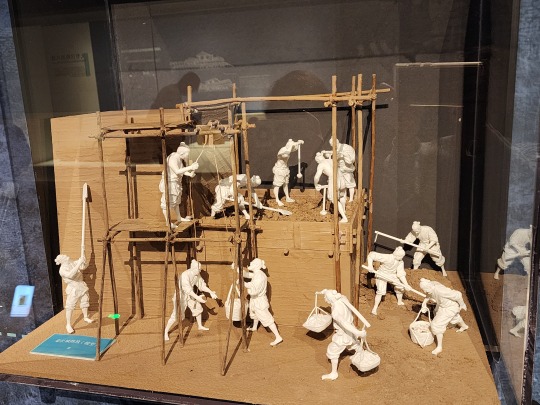
A list of the schools of thought that existed during Warring States period, their most influential figures, their scholars, and their most famous works. These include Confucianism (called Ru Jia/儒家 in Chinese; usually the suffix "家" at the end denotes a school of thought, not a religion; the suffix "教" is that one that denotes a religion), Daoism/道家, Legalism (Fa Jia/法家), Mohism/墨家, etc.
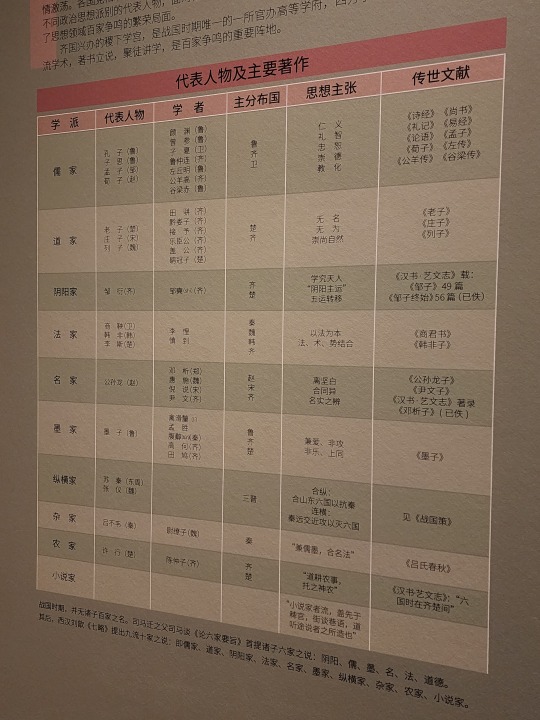
The "Five Classics" (五经) in the "Four Books and Five Classics" (四书五经) associated with the Confucian tradition, they are Shijing/《诗经》 (Classic of Poetry), Yijing/《易经》 (also known as I Ching), Shangshu/《尚书》 (Classic of History), Liji/《礼记》 (Book of Rites), and Chunqiu/《春秋》 (Spring and Autumn Annals). The "Four Books" (四书) are Daxue/《大学》 (Great Learning), Zhongyong/《中庸》 (Doctrine of the Mean), Lunyu/《论语》 (Analects), and Mengzi/《孟子》 (known as Mencius).
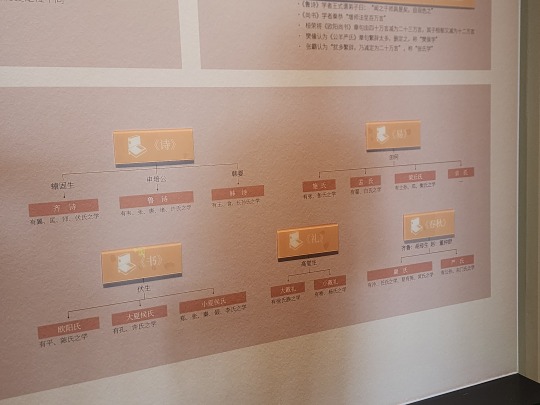
And finally the souvenir shop! Here's a Chinese chess (xiangqi/象棋) set where the pieces are fashioned like Western chess, in that they actually look like the things they are supposed to represent, compared to traditional Chinese chess pieces where each one is just a round wooden piece with the Chinese character for the piece on top:
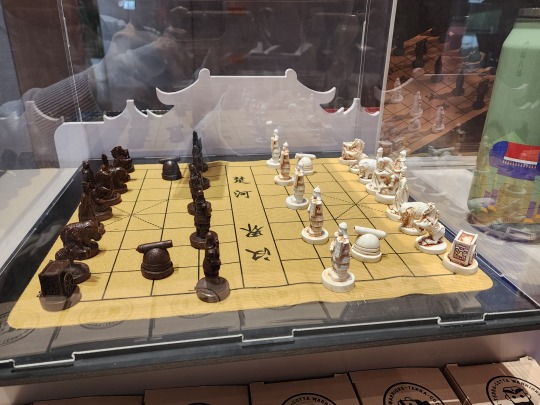
A blind box set of small figurines that are supposed to mimic Shang and Zhou era animal-shaped bronze vessels. Fun fact, in Shang dynasty people revered owls, and there was a female general named Fu Hao/妇好 who was buried with an owl-shaped bronze vessel, so that's why this set has three different owls (top left, top right, and middle). I got one of these owls (I love birds so yay!)
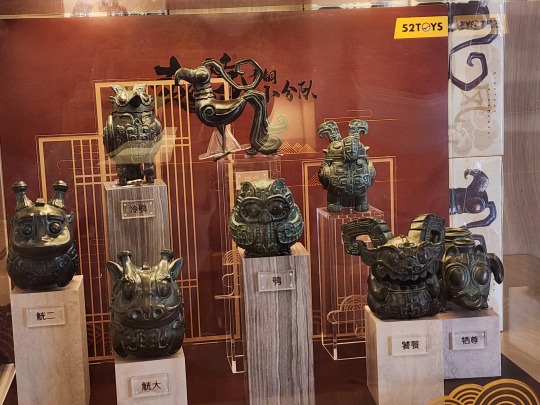
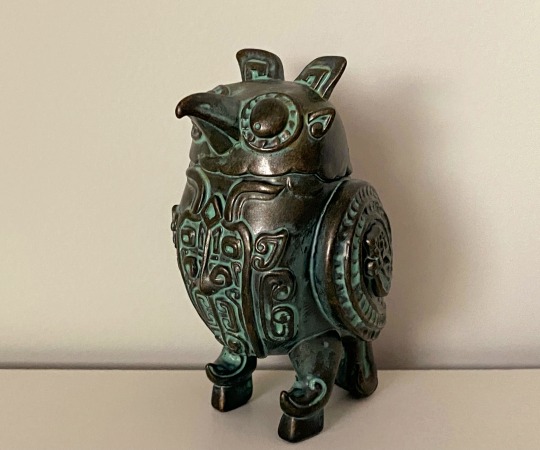
And that concludes the museums I visited while in Xi'an!
#2024 china#xi'an#china#shaanxi history museum qin and han dynasties branch#chinese history#chinese culture#chinese language#qin dynasty#han dynasty#warring states period#chinese philosophy#ancient technology#math history#history#culture#language
95 notes
·
View notes
Text
The Vases that defy time
How could the Ancient Egyptians possibly carve these one piece, hard, igneous, granite stone vases with simple, rudimentary technology? 🤔
#pay attention#educate yourselves#educate yourself#knowledge is power#reeducate yourself#reeducate yourselves#think about it#think for yourselves#think for yourself#do your homework#do your own research#do some research#ask yourself questions#question everything#ancient history#ancient technology#hidden history#history lesson#history#ancient times
119 notes
·
View notes
Text


Something that bothers me about the backstory of Tears of the Kingdom is that the fall of Zonai civilization is never explained. Even before the war with the Demon King, the Zonai already seemed to be in severe decline. During his formal surrender, Ganondorf taunts Rauru by claiming that he and his sister Mineru are the only two remaining Zonai, and there seems to be no evidence to the contrary.
As Rauru guides Link through the Gardens of Time, he explains that the Zonai used their technology to build a civilization that "flourished for many, many years," presumably before the founding of Hyrule. In Breath of the Wild, ancient technology was somewhat sinister, as demonstrated by the disasters precipitated by the malfunctions of the Divine Beasts. Was the decline of the Zonai also connected to their technology, somehow?
I'm intrigued by the implications of Rauru's meditations on the Temple of Time, which he claims was originally on the surface. I wonder how the islands floating over Hyrule came to exist, and whether their creation was perhaps an unintended consequence of Zonai technology. This is just a theory, but such disruptions to the natural environment might be a result of the use of the secret stones in particular, which might explain why Hyrule Castle suddenly rose into the sky as soon as the seal on the stones it was built to protect was broken.
#Tears of the Kingdom#Breath of the Wild#Rauru#Zonai#ancient technology#Zelda speculation#TotK spoilers
242 notes
·
View notes
Text





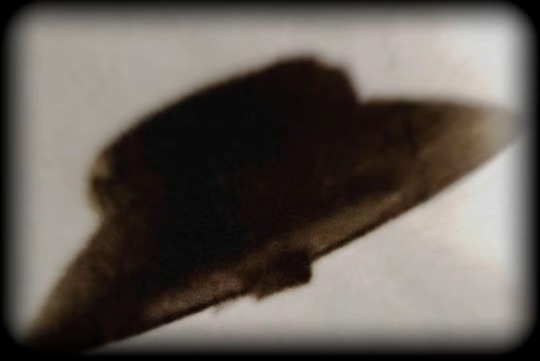


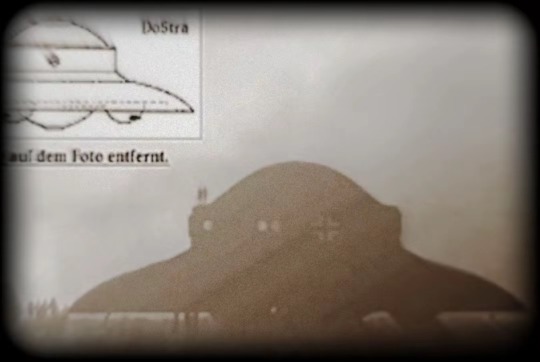

Agartha Cadilek‘s
#agartha#esoterik#occultism#esoteric#flat earth#Okkultismus#okkult#science#flugkreisel#untertasse#ufo#ufology#freimaurerei#freemason#stolen technology#old technology#ancient#ancient technology#vril#vrill#asen#thule#bmw
25 notes
·
View notes
Text
WELCOME BACK TO EVEN MORE CRACK POT ONE PIECE THEORIES WITH ME ELI
Every devil fruit awakening is slightly different between user of the same fruit
Emet (egg head robot) was joyboys franky (suuuppper) and zou was his chopper
Brook knows of islands that have been erased and some erased history and will (unintentionally) foil a government plot by revealing this info
Someone has a copy of the Vegapunk recording
Vegapunk put together that Luffy was Nika fruit users and the return of joyboy and his importance to the one piece (thus more people want to join and stop Luffy and probably massive bounty increases)
The ancient technology was lost because both sides destroyed it, to slow the other down
#one piece#one piece theory#onepiece crack pot theories#luffy#monkey d. luffy#roronoa zoro#devil fruit#devil fruit awakenings#franky one piece#egghead island#zou#Brook#soul king brook#vegapunk#vegapunk recording#joy boy#sun god nika#sun god luffy#straw hat pirates#straw hat allies#massive bounty’s#luffys bounty’s will be higher or the same as Roger’s#ancient technology#kinda what Luffy was doing on egghead#big news Morgan’s probably gonna get it and make bank
35 notes
·
View notes
Text
The first pyramids were constructed 8000 years ago with the aid of aliens in the image of their genitalia, believed to have inspired countless myths in human culture. The original pyramids and their location have since been lost to time, but projects like the Pyramids of Giza were constructed in an attempt to replicate these ancient extraterrestrial marvels.
12 notes
·
View notes
Text

#hardware#cyberpunk aesthetic#cyberpunk#scifi#vaporwave#cybernetics#cyborg#computer accessories#desert#cyberpunk girl#digging#buried#ancient technology#treasure hunt#buried treasure#treasure planet
12 notes
·
View notes
Note
Hi! I feel bad asking you this but would you consider your custom scripts for your screenshot edits? :)
I assume you meant sharing them? No problem! But keep in mind these actions will only work in Paint Shop Pro 8 (maybe other close versions of PSP but I really have no idea?). I'm fairly certain they wouldn't work in any other type of graphics editing program (Photoshop, Gimp etc).
I think PSP8 is basically abandonware at this point though and easily findable, I think I downloaded mine somewhere online years ago and today it tells me I'm on day 20,089 of my free 60 day trial!
There are two scripts I use - Screenshot Edits and Screenshot Edits Darker. They're the same but obviously, one results in a darker finished image. Both adjust curves for brightness/contrast, adjust saturation up a little (more about that below) and then apply the bloom effect I talked about and showed here.
I use the "darker" script for shots that only need a slight bit of brightening because they're already fairly bright and would become overexposed, or for dark shots that should stay relatively dark (like nighttime shots). I also tweak the saturation enhancement settings per image depending on its needs. Sometimes the "default" settings on the script are just right, but sometimes it will desaturate or oversaturate, so it sometimes needs a tweak. There's only a few variables to play with in that screen so you get a feel for it pretty easily.
These scripts don't include cropping or resizing, I do that manually.
Hope this helps! :) These scripts for me were in this folder path: D:\My PSP8 Files\Scripts-Trusted
But there is also a folder path on my computer called: C:\Program Files (x86)\Jasc Software Inc\Paint Shop Pro 8\Scripts-Trusted
So presumably either would work?? Not sure what the difference is! But just FYI!
Download (SFS) | Download (MF)
8 notes
·
View notes
Text

Pre-Columbian civilizations across the Americas developed various adhesives used in everyday applications and ceremonial contexts. These adhesives were crafted from natural materials, such as plant resins, tree gums, and animal-based glues, with their use spanning numerous cultural groups, including the Maya, Aztec, Inca, and Moche. By understanding the properties of their surrounding environment, these cultures could create adhesives suitable for tool-making, repairing objects, crafting jewelry, and producing artwork.
This article will focus on the adhesives used by these ancient cultures, how they were made, and the specific applications seen in archaeological findings.
Moche Wood Scepter c. 400-800 AD. closeup view
Moche wood scepter w/ inlaid Shell and Stones
Materials Used in Pre-Columbian Adhesives
Pre-Columbian adhesives were primarily sourced from plant resins, tree gums, and animal derivatives. Each civilization developed unique techniques to harvest and process these natural materials to suit their environmental and cultural needs.
Plant Resins and Tree Gums
Plant resin was one of pre-Columbian cultures’ most widely used adhesive materials. Resins such as copal, commonly used by the Maya and other Mesoamerican civilizations, were derived from trees in the Burseraceae family. The Maya used copal resin for both ritual and practical purposes. It was often burned as incense in religious ceremonies, but in a solid form, it was an adhesive for binding materials such as stone and wood.
The Aztecs also exploited natural resins, particularly pine resin. Pine resin was commonly mixed with natural powders like ash or powdered stone to enhance its adhesive properties. This combination was often applied to tools, pottery repairs, or affixing feathers and stones to wooden or clay artifacts.
Animal-Based Adhesives
In some pre-Columbian cultures, animal-based adhesives were also used, although these were less documented than plant resins. These adhesives were typically made by boiling animal hides, bones, or tendons to produce gelatinous substances that, when cooled, formed a strong bond. Andean civilizations, such as the Inca, likely employed these adhesives, though less direct evidence survives than their Mesoamerican counterparts.
For example, animal-based glues may have been used in textile production to attach decorative elements such as feathers to ceremonial garments or headpieces. However, animal-based adhesives’ exact prevalence and variety are not as well-documented as resin-based adhesives.
Methods of Production and Application
The production of adhesives in the pre-Columbian Americas required an understanding of local materials and their properties. Though methods varied between cultures, specific techniques were standard across regions.
Resin Extraction and Processing
Plant resins like copal were often harvested by cutting into the bark of resin-producing trees. The resin would ooze out and harden upon exposure to air, after which it could be collected and stored. When needed, the hardened resin was heated over a fire or other heat source until it became a thick liquid. Once liquefied, it could be applied to objects as an adhesive.
For specific applications, additives like powdered stone or pigments were mixed into the resin to adjust its texture or increase its durability. For example, this practice was common in affixing decorative stones to jewelry or securing blade heads to wooden shafts for tools and weapons.
Paracas Wood, Stone and Feather Club for Sale
Paracas wooden club w/inlaid Stone
Application Techniques
Adhesives were applied directly to the surfaces that needed bonding, often in thin layers. When used to repair pottery, artisans would apply the glue to the broken edges and carefully press the pieces together, holding them in place until the resin hardened. In some cases, additional adhesive was applied over the joints to reinforce the bond.
For weaponry and tools, adhesives were often used with other fastening techniques. For example, in Mesoamerican cultures, resin might have been used to help secure stone blades to wooden handles, followed by wrapping the joint with plant fibers for additional strength.
Cultural Examples of Adhesive Use
Several archaeological findings highlight the importance of adhesives in pre-Columbian material culture. Below are examples of how various civilizations across the Americas used adhesives.
Maya Copal Resin
The Maya extensively used copal resin for ceremonial incense and as an adhesive for repairing ceramics and affixing small decorative stones or shells to larger objects. For instance, archaeologists have found examples of jade and shell inlays on wooden objects in Maya tombs held in place by hardened copal resin.
Aztec Featherwork
Featherwork, a vital art form in Aztec and Maya civilizations, required adhesives to attach vibrant bird feathers to textiles, shields, and headdresses. In Aztec society, feather artisans, known as amantecas, used a combination of plant-based resins, such as pine resin, to bind the feathers in place. The featherwork pieces served decorative and religious purposes, demonstrating the adhesive’s role in crafting items of cultural significance.
Inca Wood and Stone Artifacts
In the Andean regions, particularly within the Inca Empire, adhesives were employed in various woodworking and stone-carving techniques. For example, adhesives were used to fasten metal or stone inlays into wooden objects, such as ceremonial staffs or chicha cups. Additionally, using resin-based adhesives for pottery repair has been suggested by analyzing broken and mended artifacts found in Inca archaeological sites.
Moche Metalworking
The Moche civilization of northern Peru is known for its advanced metallurgy and intricate artwork. Moche artisans likely used plant-based adhesives in their fine metalworking to affix precious stones or inlays into metal pieces. Some surviving Moche metal objects, such as ornamental plaques and jewelry, show evidence of adhered stone inlays using organic adhesives.
Moche Pututu Trumpet Shell Horn front side view
Moche Pututu Shell – Waylla Kepa w/ inlaid Silver Mouth Piece
Wari Mask Product for Sale
Wari False Head w/inlaid Shells
Conclusion
Pre-Columbian adhesives played a crucial role in the daily and ceremonial lives of the Maya, Aztecs, Inca, and other ancient civilizations. By utilizing plant resins like copal and pine and possibly animal-derived glues, these cultures produced durable and versatile adhesives for repairing ceramics, crafting tools, and creating intricate works of art. The widespread use of these adhesives, as demonstrated by surviving artifacts, provides insight into the technological sophistication of these pre-Columbian societies. Their understanding of natural resources allowed them to create functional and integral materials for their cultural and artistic practices, ensuring that these innovations would endure through the ages.
How to Determine Cotton Fabric from Camelid Fibers Accurately?
Research Academic Papers and News Articles
#ancient art#ancient history#archaeology#pre-columbian#art history#artifacts#inca#aztec#mayan#south america#ancient technology
9 notes
·
View notes
Text

My ancient Dell laptop fired up for the first time in almost 2 decades like it was yesterday!

I mainly used it for making beats on early FL Studio and Sound Forge software. I can still edit these, insane. What a time capsule! Finally found the power cord so I just had to see if it still worked.



Look how many sexy ports, 8 just on the back! Fuck new laptops, I have 4 on my new Surface!
#retro electronics#dell laptop#fl studio#2000s#y2k tech#windows xp#mine#computer#computer ports#ancient technology#throwback
26 notes
·
View notes
Text

Nooooooooooo!!!! It's finally happened, my ancient iPad can no longer update any browser windows to access Ao3 after their latest update 😭😭😭😭😭 I had kept the rust bucket purely for browsing/downloading all my stony fics so they were all on one device and the dream is over.
#ao3#tony stark#steve rogers#stony#iron man#marvel#avengers#mcu#avengers family#ancient technology#a starkpad would never do this to me
19 notes
·
View notes
